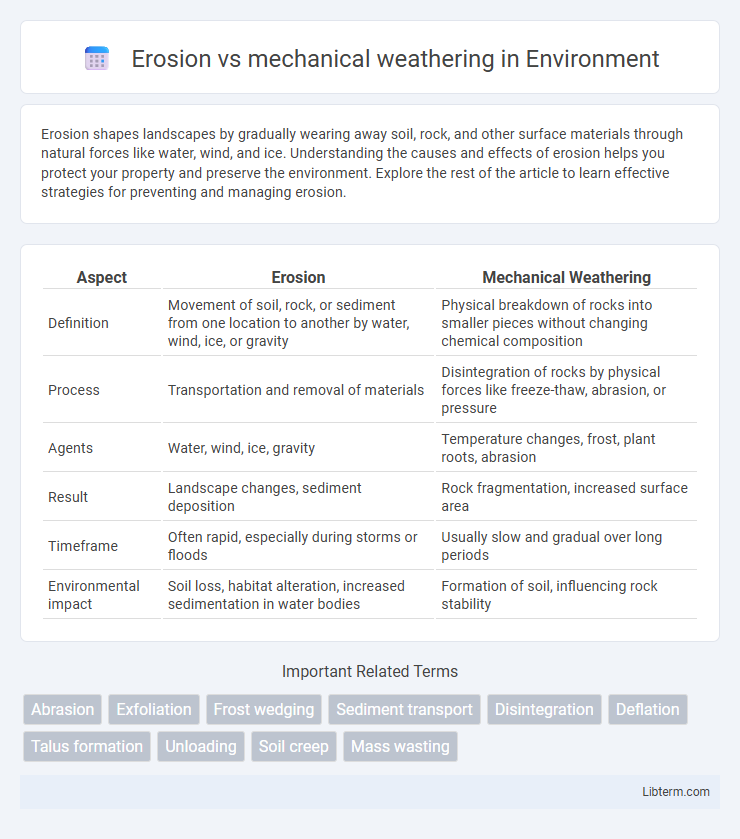Erosion shapes landscapes by gradually wearing away soil, rock, and other surface materials through natural forces like water, wind, and ice. Understanding the causes and effects of erosion helps you protect your property and preserve the environment. Explore the rest of the article to learn effective strategies for preventing and managing erosion.
Table of Comparison
| Aspect | Erosion | Mechanical Weathering |
|---|---|---|
| Definition | Movement of soil, rock, or sediment from one location to another by water, wind, ice, or gravity | Physical breakdown of rocks into smaller pieces without changing chemical composition |
| Process | Transportation and removal of materials | Disintegration of rocks by physical forces like freeze-thaw, abrasion, or pressure |
| Agents | Water, wind, ice, gravity | Temperature changes, frost, plant roots, abrasion |
| Result | Landscape changes, sediment deposition | Rock fragmentation, increased surface area |
| Timeframe | Often rapid, especially during storms or floods | Usually slow and gradual over long periods |
| Environmental impact | Soil loss, habitat alteration, increased sedimentation in water bodies | Formation of soil, influencing rock stability |
Introduction to Erosion and Mechanical Weathering
Erosion involves the movement of soil, rock, and sediment by natural forces such as water, wind, or ice, reshaping landscapes over time. Mechanical weathering, also known as physical weathering, breaks down rocks into smaller pieces without chemical change through processes like freeze-thaw cycles and abrasion. Both processes contribute to surface modification, but erosion actively transports material, while mechanical weathering disintegrates rock in place.
Defining Erosion: Processes and Examples
Erosion is the natural process by which soil, rock, and sediment are worn away and transported from one location to another, primarily through agents like water, wind, ice, and gravity. Unlike mechanical weathering, which breaks down rocks in place without movement, erosion involves the physical removal and displacement of material, shaping landscapes through phenomena such as riverbank erosion, coastal abrasion, and glacial retreat. Key examples of erosion include the Grand Canyon formation by the Colorado River and coastal cliff recession caused by waves.
Understanding Mechanical Weathering: Key Mechanisms
Mechanical weathering breaks down rocks through physical forces such as freeze-thaw cycles, abrasion, and exfoliation, without altering their chemical composition. Freeze-thaw processes cause cracks as water repeatedly freezes and thaws, expanding and contracting within rock fissures. Abrasion occurs when particles carried by wind, water, or ice scrape against rock surfaces, gradually wearing them down.
Major Differences Between Erosion and Mechanical Weathering
Erosion involves the transportation of rock particles by agents such as water, wind, ice, or gravity, whereas mechanical weathering refers to the physical breakdown of rocks without movement. Mechanical weathering processes include freeze-thaw cycles, thermal expansion, and abrasion, which disintegrate rocks in their original location. Erosion results in sediment displacement and landscape reshaping, contrasting with mechanical weathering's role in rock fragmentation at the source.
Agents of Erosion: Water, Wind, Ice, and Gravity
Water, wind, ice, and gravity are primary agents of erosion that transport soil, rock, and sediment from one location to another, reshaping landscapes over time. Water erosion occurs through rivers, rainfall, and ocean waves, carving valleys and transporting sediments downstream. Wind erosion affects arid regions by lifting and moving fine particles, while ice glaciers grind and sculpt terrain; gravity drives mass wasting events like landslides that rapidly relocate material downslope.
Agents of Mechanical Weathering: Temperature, Pressure, and Biological Factors
Mechanical weathering occurs through physical processes that break rocks without altering their chemical composition, driven primarily by agents such as temperature changes, pressure fluctuations, and biological factors. Temperature variations cause expansion and contraction in rock materials, leading to fracturing, while pressure release results in exfoliation and joint formation. Biological factors contribute through root wedging and burrowing organisms that exert physical force, accelerating rock disintegration.
Environmental Impacts of Erosion vs Mechanical Weathering
Erosion accelerates soil degradation and habitat loss by transporting sediment and pollutants across landscapes, often leading to water quality issues in downstream ecosystems. Mechanical weathering breaks down rocks into smaller particles in situ, minimally disturbing surrounding environments but contributing to soil formation and landscape changes over time. The environmental impact of erosion is generally more immediate and widespread, causing significant alterations to land stability and aquatic systems compared to the localized and gradual effects of mechanical weathering.
Role in Landscape Formation: Erosion vs Mechanical Weathering
Erosion actively transports soil, rock, and sediment from one location to another, reshaping landscapes through processes like water flow, wind, and glacial movement. Mechanical weathering breaks down rocks in situ by physical forces such as freeze-thaw cycles, abrasion, and thermal expansion, creating smaller fragments without displacement. Together, erosion redistributes weathered materials, while mechanical weathering increases the availability of sediment that erosion can carry away, collaboratively sculpting diverse landforms.
Human Activities Influencing Erosion and Mechanical Weathering
Human activities such as deforestation, urbanization, and agriculture accelerate erosion by removing vegetation cover and disturbing soil structure, leading to increased sediment runoff into water bodies. Construction, mining, and heavy machinery intensify mechanical weathering by physically breaking down rocks and soil through abrasion and compaction. These anthropogenic actions significantly alter natural erosion rates and mechanical weathering processes, impacting landscape stability and ecosystem health.
Mitigation and Prevention Strategies for Erosion and Weathering
Mitigation and prevention strategies for erosion and mechanical weathering center on stabilizing soil and reducing surface runoff through vegetation cover, terracing, and the use of geotextiles. Implementing contour plowing and maintaining riparian buffer zones effectively minimize soil displacement by water and wind erosion. Engineering solutions like retaining walls and slope reinforcement are essential to control mechanical weathering-induced degradation in vulnerable landscapes.
Erosion Infographic

 libterm.com
libterm.com